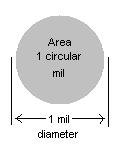- Joined
- May 27, 2016
- Messages
- 3,469
OK - I know a "mil" is 0.001", a thousandth of an inch, also called "thou", which for me is already a bit of a discomfort, because here (UK), "mil" is just short slang for millimetres (mm). But now, I have also found "circular mils" (cmil), and additionally, "square mils" even, which appear to equal 1.273 of the circular kind.
In inch-land, a square inch is about 1.273 million of them! Yep - it's an AREA.
So one circular mil is 0.7854 square mils. It's the area of a circle 0.001" in diameter.

1 cmil = (π/4)*(0.001 in)^2
There is hardly any point going metric with this, given the alternative meaning of mils, but for those who care, try 5.067E-04 square millimetres.
I get it that Canadian and US wire gauge tables ran out of steam at 0000 AWG, but then, for the yet bigger fatter wires, they chose this very tiny unit, so now they can know the sizes in many hundreds, or some thousands of these things. Other than that 1000 of them gets you a 1.000 inch diameter, so hardly still a "wire", WHY they thought this was a good idea is, no doubt, some whole other story!
In inch-land, a square inch is about 1.273 million of them! Yep - it's an AREA.
So one circular mil is 0.7854 square mils. It's the area of a circle 0.001" in diameter.

1 cmil = (π/4)*(0.001 in)^2
There is hardly any point going metric with this, given the alternative meaning of mils, but for those who care, try 5.067E-04 square millimetres.
I get it that Canadian and US wire gauge tables ran out of steam at 0000 AWG, but then, for the yet bigger fatter wires, they chose this very tiny unit, so now they can know the sizes in many hundreds, or some thousands of these things. Other than that 1000 of them gets you a 1.000 inch diameter, so hardly still a "wire", WHY they thought this was a good idea is, no doubt, some whole other story!

